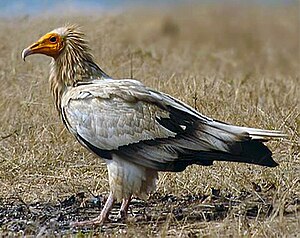Egyptian vulture: Difference between revisions
m robot Adding: ml:തോട്ടിക്കഴുകൻ |
|||
| Line 79: | Line 79: | ||
[[Category:Birds of Iran]] |
[[Category:Birds of Iran]] |
||
[[Category:Birds of Pakistan]] |
[[Category:Birds of Pakistan]] |
||
[[Category:Birds of Palestine]] |
|||
[[af:Egiptiese aasvoël]] |
[[af:Egiptiese aasvoël]] |
||
Revision as of 20:36, 5 August 2010
| Egyptian Vulture | |
|---|---|

| |
| Adult of south Asian subspecies in worn or "painted" plumage | |
| Scientific classification | |
| Kingdom: | |
| Phylum: | |
| Class: | |
| Order: | Falconiformes (or Accipitriformes, q.v.)
|
| Family: | |
| Genus: | Neophron |
| Species: | N. percnopterus
|
| Binomial name | |
| Neophron percnopterus | |
The Egyptian Vulture (Neophron percnopterus)[1] is a small Old World vulture, found from southwestern Europe and northern Africa to southern Asia. It is the only living member of the genus Neophron.[2] In Southern Asia this species is called the Scavenger Vulture.
Taxonomy
There are three recognised subspecies of the Egyptian Vulture:[3]
- N. p. percnopterus, the nominate subspecies, has the largest range, occurring in southern Europe, northern Africa, the Middle East, Central Asia and the north-west of the Indian subcontinent
- N. p. ginginianus, the smallest subspecies, occurs in most of the Indian subcontinent
- N. p. majorensis, the Canarian Egyptian Vulture, the largest subspecies with by far the smallest and most restricted population, is found only in the eastern Canary Islands
Description

The adult Egyptian Vulture usually measures 85 cm from the point of the beak to the extremity of the tail feathers and 1.7 meters between the tips of the wings. It weighs about 2.1 kilograms.
The adult plumage is white, with some black feathers in the wings and tail. Due to its habits—stalking around carcasses on usually dusty ground to wait for its turn—the plumage dulls quickly, and birds before moult are beige rather than pure white. Also, individuals occasionally seem to "paint" themselves with soil containing iron oxide, as Lammergeiers do, turning their plumage a pinkish buff; hence the German name Schmutzgeier ("dirt-vulture"). Its facial skin is yellow, turning orange during nesting periods, and is devoid of feathers. The face's change in the density of pigment is an example of an honest signal of health. This is because to achieve it the vultures must consume manure (often from cows), which is high in carotenes, the precursor for the pigment. Crucially, the manure is very high in microbes also. Only a healthy, strong vulture will be able to deal with these high levels of microbes. Therefore the strength of pigmentation is an indication how good a mate the vulture will be and so this colouration becomes part of the consideration in mating. The tail is diamond-shaped, so it is easily distinguished in flight. The shape of the tail trades off speed and for improved manoeuvrability.
The nominate subspecies has a yellow bill with a black tip, whereas the smaller Indian race has an all-yellow bill
The nestlings are dark brown and gradually become lighter until they reach adulthood at the age of five.
Distribution

Egyptian Vultures are widely distributed and may be found in southern Europe, in northern Africa, and in western and southern Asia.
They are partial migrants, depending on the local climate. If an Egyptian Vulture can endure the winter, it usually will not migrate. The species is not well adapted for cold weather due to its small size (see Bergmann's Rule).
Conservation status

From John Gould's Birds of Europe
The Egyptian Vulture is declining in large parts of its range, often severely. In Europe and most of the Middle East, it is half as plentiful as it was about twenty years ago, and the populations in India and southwestern Africa have collapsed entirely. In the case of India, this apparently is attributable to the widespread use of the NSAID Diclofenac in veterinary medicine, which enters the food chain of the species; the drug is extremely poisonous to vultures. Consequently, this species was uplisted from Least Concern to Endangered status in the 2007 IUCN Red List.[4]
Cultural significance
| |
In Ancient Egypt, the vulture hieroglyph was the uniliteral sign used for the glottal sound (3).
Footnotes
- ^ Ali & Ripley (1983)
- ^ Supposed prehistoric species from the Neogene of North America are now placed in the genus Neophrontops (the name meaning "looks like Neophron") These birds probably were almost identical to the Egyptian Vulture in lifestyle, but do not seem to have been closely related at all.
- ^ Donázar, José Antonio; Negro, Juan José; Palacios, César Javier; Gangoso, Laura; Godoy, José Antonio; Ceballos, Olga; Hiraldo, Fernando; & Capote, Nieves. (2002). Description of a new subspecies of the Egyptian Vulture (Accipitridae: Neophron percnopterus) from the Canary Islands. Journal of Raptor Research 36(1): 17-23.[1]
- ^ See BirdLife International (2007a,b).
References
- Ali, Salim & Sidney Dillon Ripley (1983): Handbook of the Birds of India and Pakistan, 2nd ed. vol.1, #186: p. 310. Oxford University Press, New Delhi.
- Template:IUCN2006
- BirdLife International (2007a): [ 2006-2007 Red List status changes ]. Retrieved 2007-AUG-26.
- BirdLife International 2007b): Egyptian Vulture - BirdLife Species Factsheet. Retrieved 2007-AUG-28.

